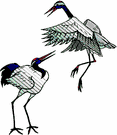In a post yesterday, I added updated info on Lesser Prairie-Chicken viewing in Colorado. I thought I would provide more about viewing options.
There is one
public lek in Colorado (limited to one so as to keep disturbance to just one area). This lek is located 12 miles east of
Campo in far southeast Colorado. It is about a 45 minute drive to the lek from the nearest lodging in Springfield, Colo which has several motels and an RV campground.
In order to use the public lek, it is necessary to call the Forest Service (they manage the
Comanche National Grasslands where this lek is located)office in Springfield before your planned visit to get updated information and arrange to check out a key (if it is not already reserved) to the very small blind. Since it is necessary to get to the viewing area at least an hour before dawn (in order to minimize disturbance to the birds and dawn ranges from around 5:30-6:30 am). It is also necessary to do a dry run in the daylight as the viewing area is located in a field off a county road, and the turn-off is not highly visible (especially in the dark) and you want to make sure you don't turn into some farmer's field in the middle of the night.
It is also helpful to drive out on the sandy county road to the lek in the daylight as the route goes through minimally populated areas (it is best to use the driving directions provided by the Forest Service as some roads turn into 2-tracks and they choose the better county roads). It is also helpful to practice driving on these very sandy roads as the sand can be deep in sections which can cause hydro-planing if you drive too fast. And it is important to see that the edges of the road drop off steeply so you want to be careful not to go too far towards them. You especially want to see where the turn-off is as you will be taking a 2-track out into a field to get to the lek parking area.
When I visited the public lek two years ago, I decided to view the birds displaying at dusk (a less preferred time)as I didn't like the idea of driving out in the middle of the night by myself. This did mean that I had to drive out in the dark (as it is necessary to stay put for an hour after the birds disperse in order to reduce disruption to the birds) but this seemed less daunting to me. I also decided after seeing the rather rugged viewing blind to stay in my car instead. Though I don't know that snakes could get into the blind, I am sure that spiders can; and I did't relish being in this small (holds only 2-4 people) dugout building in the dark with unseen critters.
Some of you may find the adventure of using the public lek acceptable. For those who are not up for an adventure and would prefer a more civilized viewing then
Arena Dust Tours is a great option. You will drive out to the Dorenkamp's ranch house near Granda which is only 15 miles east of Lamar, Colorado (which gives you a number of lodging options including renting a bedroom in the Dorenkamp's basement). You won't have to worry about getting lost or driving into a ditch since Mr. Dorenkamp (who knows this country like the back of his hand) will drive you from his ranch house to the viewing lek in his vehicle. Depending on which lek has the best viewing, you will either stay in his vehicle or you will be able to use a new, updated Division of Wildlife viewing blind. Besides the safe,escorted tour, you get light refreshments when you arrive at the Dorenkamp's ranch house, the benefit of Mr. Dorenkamps extensive historical knowledge of the area, the opportunity to view other species on the drive back after the viewing in the early am--all for $50/person.
Or you could join one of the professional tour groups that have trips to view all Colorado grouse and spend between $2,100 to $2,500 per person for these 9-10 day statewide tours or $1,500 for a 7 day specialized tour.
Though I have not personally been to the private leks available with Arena Dust Tours, I have met Mr and Mrs. Dorenkamp at a Colorado Birding Trail landowner meeting. They are very nice and well respected. This is truly a mom and pop (actually a grandmom and grandpop) business, the type of small birding business that is good for conservation that I fully support. I do not have any financial interest in this venture and do not receive any money for referrals--this is a part of my efforts to support conservation birding.
You can get more information about Arena Dust Tours
here or call the Dorenkamps at 719-734-5226
SeEtta













